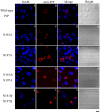Glycosylation Significantly Inhibits the Aggregation of Human Prion Protein and Decreases Its Cytotoxicity
- PMID: 30135544
- PMCID: PMC6105643
- DOI: 10.1038/s41598-018-30770-6
Glycosylation Significantly Inhibits the Aggregation of Human Prion Protein and Decreases Its Cytotoxicity
Erratum in
-
Author Correction: Glycosylation Significantly Inhibits the Aggregation of Human Prion Protein and Decreases Its Cytotoxicity.Sci Rep. 2018 Sep 4;8(1):13486. doi: 10.1038/s41598-018-31650-9. Sci Rep. 2018. PMID: 30177728 Free PMC article.
Abstract
Prion diseases are primarily caused by the misfolding of prion proteins in humans, cattle, sheep, and cervid species. The effects of glycosylation on prion protein (PrP) structure and function have not been thoroughly elucidated to date. In this study, we attempt to elucidate the effects of glycosylation on the aggregation and toxicity of human PrP. As revealed by immunocytochemical staining, wild-type PrP and its monoglycosylated mutants N181D, N197D, and T199N/N181D/N197D are primarily attached to the plasma membrane. In contrast, PrP F198S, a pathological mutant with an altered residue within the glycosylation site, and an unglycosylated PrP mutant, N181D/N197D, primarily exist in the cytoplasm. In the pathological mutant V180I, there is an equal mix of membranous and cytoplasmic PrP, indicating that N-linked glycosylation deficiency impairs the correct localization of human PrP at the plasma membrane. As shown by immunoblotting and flow cytometry, human PrP located in the cytoplasm displays considerably greater PK resistance and aggregation ability and is associated with considerably higher cellular ROS levels than PrP located on the plasma membrane. Furthermore, glycosylation deficiency enhances human PrP cytotoxicity induced by MG132 or the toxic prion peptide PrP 106-126. Therefore, we propose that glycosylation acts as a necessary cofactor in determining PrP localization on the plasma membrane and that it significantly inhibits the aggregation of human PrP and decreases its cytotoxicity.
Conflict of interest statement
The authors declare no competing interests.
Figures










Similar articles
-
Glycoform-selective prion formation in sporadic and familial forms of prion disease.PLoS One. 2013;8(3):e58786. doi: 10.1371/journal.pone.0058786. Epub 2013 Mar 19. PLoS One. 2013. PMID: 23527023 Free PMC article.
-
Neutralizing Mutations Significantly Inhibit Amyloid Formation by Human Prion Protein and Decrease Its Cytotoxicity.J Mol Biol. 2020 Feb 14;432(4):828-844. doi: 10.1016/j.jmb.2019.11.020. Epub 2019 Dec 9. J Mol Biol. 2020. PMID: 31821812
-
Cytoskeleton-dependent clustering of membrane-bound prion protein on the cell surface.J Biol Chem. 2021 Jan-Jun;296:100359. doi: 10.1016/j.jbc.2021.100359. Epub 2021 Feb 2. J Biol Chem. 2021. PMID: 33539927 Free PMC article.
-
Methionine oxidation within the prion protein.Prion. 2020 Dec;14(1):193-205. doi: 10.1080/19336896.2020.1796898. Prion. 2020. PMID: 32744136 Free PMC article. Review.
-
Evolving views in prion glycosylation: functional and pathological implications.Biochimie. 2003 Jan-Feb;85(1-2):33-45. doi: 10.1016/s0300-9084(03)00040-3. Biochimie. 2003. PMID: 12765773 Review.
Cited by
-
Inducing prion protein shedding as a neuroprotective and regenerative approach in pathological conditions of the brain: from theory to facts.Neural Regen Res. 2023 Sep;18(9):1869-1875. doi: 10.4103/1673-5374.366496. Neural Regen Res. 2023. PMID: 36926701 Free PMC article. Review.
-
The Role of Cellular Prion Protein in Promoting Stemness and Differentiation in Cancer.Cancers (Basel). 2021 Jan 6;13(2):170. doi: 10.3390/cancers13020170. Cancers (Basel). 2021. PMID: 33418999 Free PMC article. Review.
-
Neurexin facilitates glycosylation of Dystroglycan to sustain muscle architecture and function in Drosophila.Commun Biol. 2024 Nov 9;7(1):1481. doi: 10.1038/s42003-024-07191-5. Commun Biol. 2024. PMID: 39521920 Free PMC article.
-
Glycosylation of a Nonfibrillizing Appendage Alters the Self-Assembly Pathway of a Synthetic β-Sheet Fibrillizing Peptide.J Phys Chem B. 2021 Jun 24;125(24):6559-6571. doi: 10.1021/acs.jpcb.1c02083. Epub 2021 Jun 15. J Phys Chem B. 2021. PMID: 34128680 Free PMC article.
-
A novel subtype of sporadic Creutzfeldt-Jakob disease with PRNP codon 129MM genotype and PrP plaques.Acta Neuropathol. 2023 Jul;146(1):121-143. doi: 10.1007/s00401-023-02581-1. Epub 2023 May 8. Acta Neuropathol. 2023. PMID: 37156880 Free PMC article.
References
Publication types
MeSH terms
Substances
LinkOut - more resources
Full Text Sources
Other Literature Sources
Research Materials

